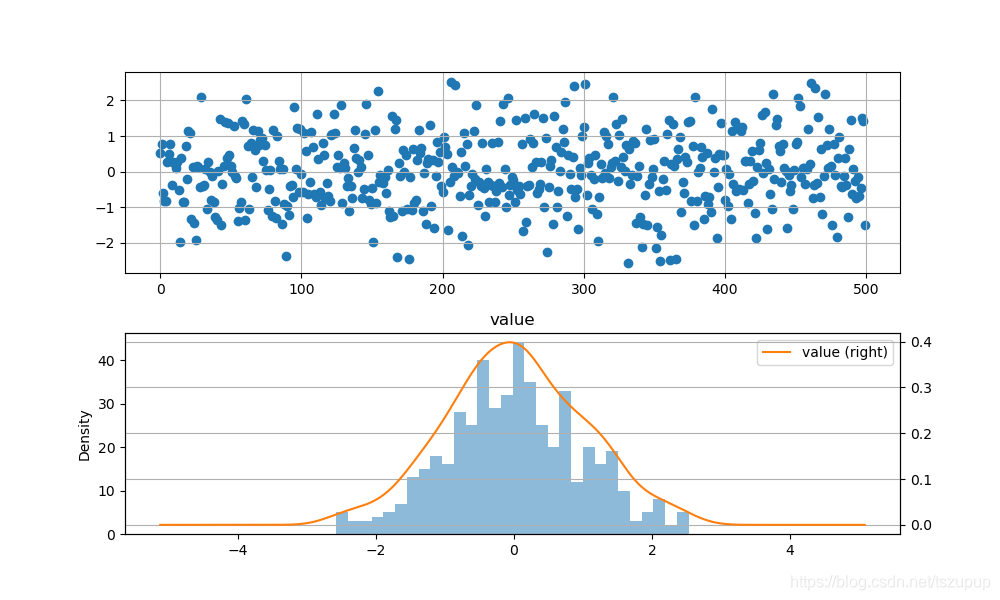| Python检验样本是否服从正态分布 | 您所在的位置:网站首页 › 判断数据是否正态分布 › Python检验样本是否服从正态分布 |
Python检验样本是否服从正态分布
|
在进行t检验、F检验之前,我们往往要求样本大致服从正态分布,下面介绍两种检验样本是否服从正态分布的方法。 1 可视化我们可以通过将样本可视化,看一下样本的概率密度是否是正态分布来初步判断样本是否服从正态分布。 代码如下: import numpy as np import pandas as pd import matplotlib.pyplot as plt # 使用pandas和numpy生成一组仿真数据 s = pd.DataFrame(np.random.randn(500),columns=['value']) print(s.shape) # (500, 1) # 创建自定义图像 fig = plt.figure(figsize=(10, 6)) # 创建子图1 ax1 = fig.add_subplot(2,1,1) # 绘制散点图 ax1.scatter(s.index, s.values) plt.grid() # 添加网格 # 创建子图2 ax2 = fig.add_subplot(2, 1, 2) # 绘制直方图 s.hist(bins=30,alpha=0.5,ax=ax2) # 绘制密度图 s.plot(kind='kde', secondary_y=True,ax=ax2) # 使用双坐标轴 plt.grid() # 添加网格 # 显示自定义图像 plt.show()可视化图像如下:
从图中可以初步看出生成的数据近似服从正态分布。为了得到更具说服力的结果,我们可以使用统计检验的方法,这里使用的是.scipy.stats中的函数。 2 统计检验 1)kstestscipy.stats.kstest函数可用于检验样本是否服从正态、指数、伽马等分布,函数的源代码为: def kstest(rvs, cdf, args=(), N=20, alternative='two-sided', mode='approx'): """ Perform the Kolmogorov-Smirnov test for goodness of fit. This performs a test of the distribution F(x) of an observed random variable against a given distribution G(x). Under the null hypothesis the two distributions are identical, F(x)=G(x). The alternative hypothesis can be either 'two-sided' (default), 'less' or 'greater'. The KS test is only valid for continuous distributions. Parameters ---------- rvs : str, array or callable If a string, it should be the name of a distribution in `scipy.stats`. If an array, it should be a 1-D array of observations of random variables. If a callable, it should be a function to generate random variables; it is required to have a keyword argument `size`. cdf : str or callable If a string, it should be the name of a distribution in `scipy.stats`. If `rvs` is a string then `cdf` can be False or the same as `rvs`. If a callable, that callable is used to calculate the cdf. args : tuple, sequence, optional Distribution parameters, used if `rvs` or `cdf` are strings. N : int, optional Sample size if `rvs` is string or callable. Default is 20. alternative : {'two-sided', 'less','greater'}, optional Defines the alternative hypothesis (see explanation above). Default is 'two-sided'. mode : 'approx' (default) or 'asymp', optional Defines the distribution used for calculating the p-value. - 'approx' : use approximation to exact distribution of test statistic - 'asymp' : use asymptotic distribution of test statistic Returns ------- statistic : float KS test statistic, either D, D+ or D-. pvalue : float One-tailed or two-tailed p-value. 2)normaltestscipy.stats.normaltest函数专门用于检验样本是否服从正态分布,函数的源代码为: def normaltest(a, axis=0, nan_policy='propagate'): """ Test whether a sample differs from a normal distribution. This function tests the null hypothesis that a sample comes from a normal distribution. It is based on D'Agostino and Pearson's [1]_, [2]_ test that combines skew and kurtosis to produce an omnibus test of normality. Parameters ---------- a : array_like The array containing the sample to be tested. axis : int or None, optional Axis along which to compute test. Default is 0. If None, compute over the whole array `a`. nan_policy : {'propagate', 'raise', 'omit'}, optional Defines how to handle when input contains nan. 'propagate' returns nan, 'raise' throws an error, 'omit' performs the calculations ignoring nan values. Default is 'propagate'. Returns ------- statistic : float or array ``s^2 + k^2``, where ``s`` is the z-score returned by `skewtest` and ``k`` is the z-score returned by `kurtosistest`. pvalue : float or array A 2-sided chi squared probability for the hypothesis test. 3)shapiroscipy.stats.shapiro函数也是用于专门做正态检验的,函数的源代码为: def shapiro(x): """ Perform the Shapiro-Wilk test for normality. The Shapiro-Wilk test tests the null hypothesis that the data was drawn from a normal distribution. Parameters ---------- x : array_like Array of sample data. Returns ------- W : float The test statistic. p-value : float The p-value for the hypothesis test.下面我们使用第一部分生成的仿真数据,用这三种统计检验函数检验生成的样本是否服从正态分布(p > 0.05),代码如下: import numpy as np import pandas as pd import matplotlib.pyplot as plt # 使用pandas和numpy生成一组仿真数据 s = pd.DataFrame(np.random.randn(500),columns=['value']) print(s.shape) # (500, 1) # 计算均值 u = s['value'].mean() # 计算标准差 std = s['value'].std() # 计算标准差 print('scipy.stats.kstest统计检验结果:----------------------------------------------------') print(stats.kstest(s['value'], 'norm', (u, std))) print('scipy.stats.normaltest统计检验结果:----------------------------------------------------') print(stats.normaltest(s['value'])) print('scipy.stats.shapiro统计检验结果:----------------------------------------------------') print(stats.shapiro(s['value']))统计检验结果如下: scipy.stats.kstest统计检验结果:---------------------------------------------------- KstestResult(statistic=0.01596290473494305, pvalue=0.9995623150120069) scipy.stats.normaltest统计检验结果:---------------------------------------------------- NormaltestResult(statistic=0.5561685865675511, pvalue=0.7572329891688141) scipy.stats.shapiro统计检验结果:---------------------------------------------------- (0.9985257983207703, 0.9540967345237732)可以看到使用三种方法检验样本是否服从正态分布的结果中p-value都大于0.05,说明服从原假设,即生成的仿真数据服从正态分布。 参考 python数据分析----卡方检验,T检验,F检验,K-S检验 python使用scipy.stats数据(正态)分布检验方法 python 如何判断一组数据是否符合正态分布 |
【本文地址】
公司简介
联系我们
